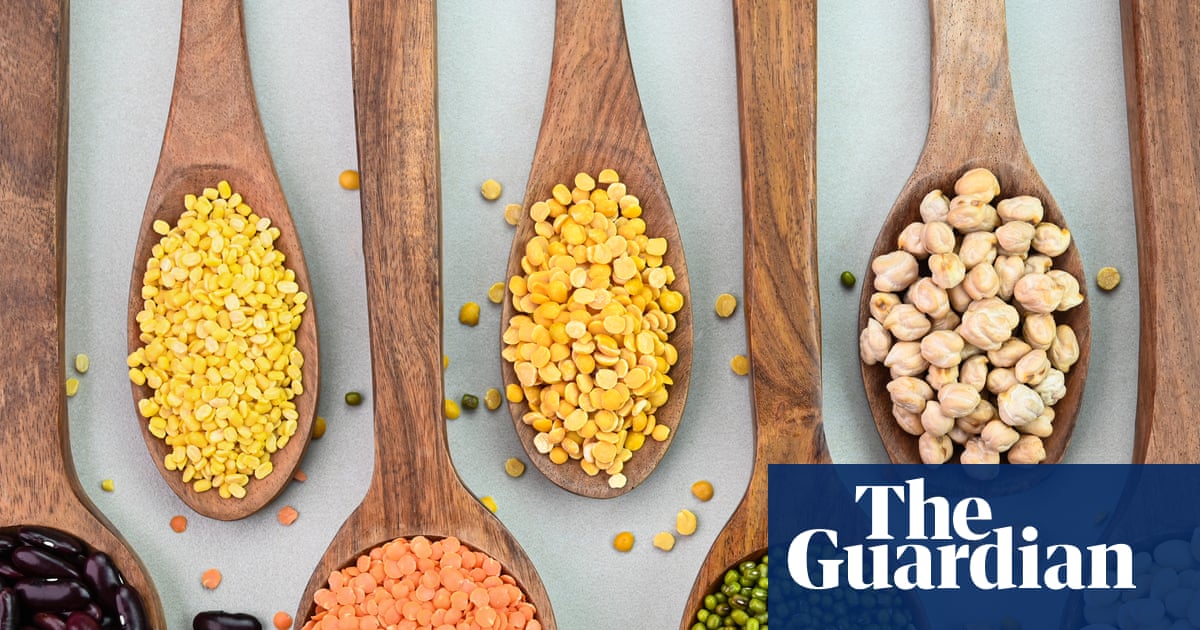The power of pulses: 15 easy, delicious ways to eat more life-changing legumes

Worried about rising food prices, your diet’s carbon footprint or whether you’re eating healthily enough? Believe it or not, there could be a magic bullet: pulses.
According to a study by the University of Reading, published in the European Journal of Nutrition in March, adults who eat more pulses – dried beans, peas and lentils – have a higher intake of nutrients including fibre, folate and vitamins C and E; minerals such as iron, zinc and magnesium; and a lower intake of saturated fat and sugar. Similar results have been found in American, Australian and Canadian research.
The UK study also found that eating pulses was associated with a more sustainable diet. In her book, Pulse: Modern Recipes with Beans, Peas & Lentils, Eleanor Maidment explains that growing pulses has a positive effect on the environment. “Many are ‘nitrogen fixers’, meaning they have the ability to convert nitrogen in the atmosphere into a form that can be used in the soil, making it more fertile for other crops,” she writes. Justine Butler, the head of research at Viva!, says: “The lowest-impact beef still creates six times the greenhouse gases and uses 36 times more land per gram of protein than peas.”
Pulses are filling and good value but, say the Reading researchers, the typical British adult eats only about 15g a day, with the average household spending just £1.68 on pulses a week. UK guidelines state that 80g of pulses (about a third of a tin) counts as one of your five a day.
The University of Reading study is part of the Raising the Pulse project, which aims to increase pulse consumption to improve public and planetary health. One of its strategies is adding fava bean (dried broad bean) flour to white bread – similar to a successful programme in Denmark using rye flour to increase wholegrain consumption. Prof Julie Lovegrove, the director of the Hugh Sinclair Unit of Human Nutrition at the University of Reading, says: “These foods are not only nutritious but also incredibly versatile, affordable and sustainable.”
If you want to start eating more pulses, here are 15 things you need to know.
You don’t have to cook pulses for hours. “Don’t be put off by the idea that you have to soak dried pulses in advance,” says Maidment. “I am rarely organised enough to do so, but thankfully there’s a huge range of jarred and canned varieties that require no prep and are hugely convenient. If you can afford to spend a bit more, then jarred varieties have the edge over canned in terms of flavour and texture. Brands such as Bold Bean Co, Brindisa or Belazu are consistently excellent.”
But batch-cooking dried pulses is the best value. Jenny Chandler, the author of Super Pulses and Pulse, soaks and cooks a big pot of pulses once a week. “You will finish up with well over double their volume – it’s a really economical way to have a ready supply. They will keep in their cooking water for five days in the fridge and you can freeze any leftovers. Use them in salads, soups, purees, curries, stews and even puddings – they will become the bedrock of your cooking.”
Pulses are for everyone. “You do not have to be vegetarian or vegan to enjoy pulses – far from it,” says Maidment. “We should all be eating more pulses. For instance, in a traybake, I’ll use one chicken thigh per person instead of two, and add a can of chickpeas or butter beans. I often add a can of lentils to bolognese. You’re still getting filling protein, but with the added benefits of gut-friendly fibre and numerous other minerals, vitamins and antioxidants.”
They make meals go much further. “Most pulses are relatively cheap and quite mild in taste, making them ideal for bulking out soups, stews and curries without affecting the original flavour,” says Maidment. “You can often use different varieties interchangeably, depending on what you have to hand.” Chandler adds a handful of cooked pulses to all sorts of dishes. “Throwing a few chickpeas or cannellini beans into a simple tomato sauce with pasta not only ups the nutritional profile, but also keeps you feeling full for much longer,” she says.
Baked beans are just the beginning. “By far the most eaten pulse in the UK is the haricot bean due to its starring role in tinned baked beans,” says Maidment. “Butter beans, cannellini beans, black beans and kidney beans are also popular, but there is a huge variety of beans to try. For instance, flageolet beans are delicate, pale-green beans popular in French cooking – try them in a slow-braised lamb stew with garlic, thyme and white wine.” Chandler loves yin yang beans, AKA calypso or orca beans. “These black and white beans are utterly beautiful and taste wonderful in chilli,” she says.
But beans on toast still rules. “My favourite pulse-based dish is garlicky beans and bitter greens on toast, topped with chilli oil,” says Joe Yonan, the author of Cool Beans.
You can make (almost) anything with chickpeas. “The chickpea is my favourite pulse, for its versatility,” says Yonan. “It is the basis of hummus, the best dip on the planet. It’s great in a coronation chickpea sandwich, and it holds its shape in salads and stews.” For a snack, Yonan mixes cooked chickpeas with olive oil and spices (such as za’atar, Chinese five spice, chaat masala or smoked paprika) and roasts them in the oven for an hour at 150C/300F. “I then turn off the oven but leave them in there to completely cool – it dries them out and makes them really satisfyingly crunchy.” He also uses chickpea (AKA gram) flour to make farinata or socca, a savoury pancake; panisse (chickpea fries); and bhajis and pakoras. “Sometimes I use it as a base for a sort of non-traditional, don’t-tell-the-Italians pizza.”
Lentils cook more quickly than most pulses. Red split lentils are especially quick, cooking in about 15 minutes. Lentils don’t need soaking, but it does reduce the cooking time. Maidment likes to experiment with different dals. “Regional Indian dals can be made with a range of lentils – yellow moong, black urad, chana dal – each bringing a slightly different flavour and texture,” says Maidment. But she also has a soft spot for tinned lentils. “I often roast drained, tinned lentils with olive oil and crushed garlic to boost their flavour and add crispness before throwing them into a salad – perhaps ricotta and prosciutto, or chopped fresh and sun-dried tomatoes, mozzarella and basil.”
Pulses make delicious dips. “Hummus is the classic, but you can blend most pulses into dips,” says Maidment. “Fava, a fabulous Greek split yellow pea dip, is absolutely worth making.” Blend cooked split yellow peas with caramelised onions and garlic, lemon juice, olive oil, salt and a little of the beans’ cooking liquor or water to make.
Pulse liquid has many uses. “Jarred and canned pulses are usually stored in a liquid known as aquafaba,” says Maidment. “It can be great for adding creaminess to savoury dishes or used as an egg alternative in baking.” She advises checking the salt levels and ingredients list before using – some pulses have added preserving and firming agents.
Black beans make the best veggie burgers, says Yonan. The Guardian’s Meera Sodha agrees. She mashes a drained tin of black beans with breadcrumbs, garlic and onion powders, chipotle paste, dijon mustard, tomato ketchup and a splash of aquafaba, shapes them into patties, then fries them in olive oil until crispy.
British pulses are having a revival. Maidment and Chandler both recommend carlin peas, pleasingly also known as black badgers, which are a heritage British pulse. They are available dried and cooked from companies such as Hodmedod’s.
“They’re small, nutty brown peas, and make a great alternative to chickpeas, with a similarly impressive nutrient profile,” says Maidment. She roasts cooked carlin peas until crispy, then adds them to salads such as quinoa, broccoli and halloumi. Chandler uses them in dips and curries, and to make a version of refried beans. “They’re much more versatile than yellow or green dried peas as they don’t have such a pronounced ‘pea’ flavour,” she says. In the US, Yonan suggests the lady pea, a spherical white bean that is popular in southern cuisine.
Pulses make great protein shakes. “A handful of cooked pulses added into a smoothie will give it a great creamy texture and make it more nourishing,” says Chandler. She adds black beans or borlotti beans to dark berry smoothies, and chickpeas, cannellini beans or butter beans to green smoothies.
Pulse-based pasta is worth a try. There is an increasing range of high-fibre pasta made from pulse flour: peas, lentils, chickpeas, black beans, mung beans … Chandler enjoys this alternative pasta, but says she doesn’t use it in classical Italian dishes: “I may use it in a pasta salad, say, or team it with a blue cheese and walnut sauce.” Yonan agrees that pulse pasta is best paired with “pungent flavours – super-garlicky or spicy”.
Pulses aren’t just for savoury dishes. Yonan makes a chocolate and chickpea tart, and adds adzuki beans to brownies. “Adzuki beans are used in a lot of Asian desserts, such as mochi and ice-cream,” he says. Maidment prefers to use kidney beans in her brownies, while Chandler has a recipe for a simple chocolate and cannellini bean mousse. Drain and retain the liquid from a tin of cannellini beans. Blitz the beans with 150g of melted dark chocolate and an optional tablespoon of cocoa powder. Whisk the liquid for five to 10 minutes, until frothy. Fold into the melted chocolate and bean mix, and sweeten with a couple of tablespoons of maple or date syrup. Chill the mix before eating, perhaps topped with some chopped stem ginger in syrup, or served with fresh raspberries.
Do you have an opinion on the issues raised in this article? If you would like to submit a response of up to 300 words by email to be considered for publication in our letters section, please click here.











